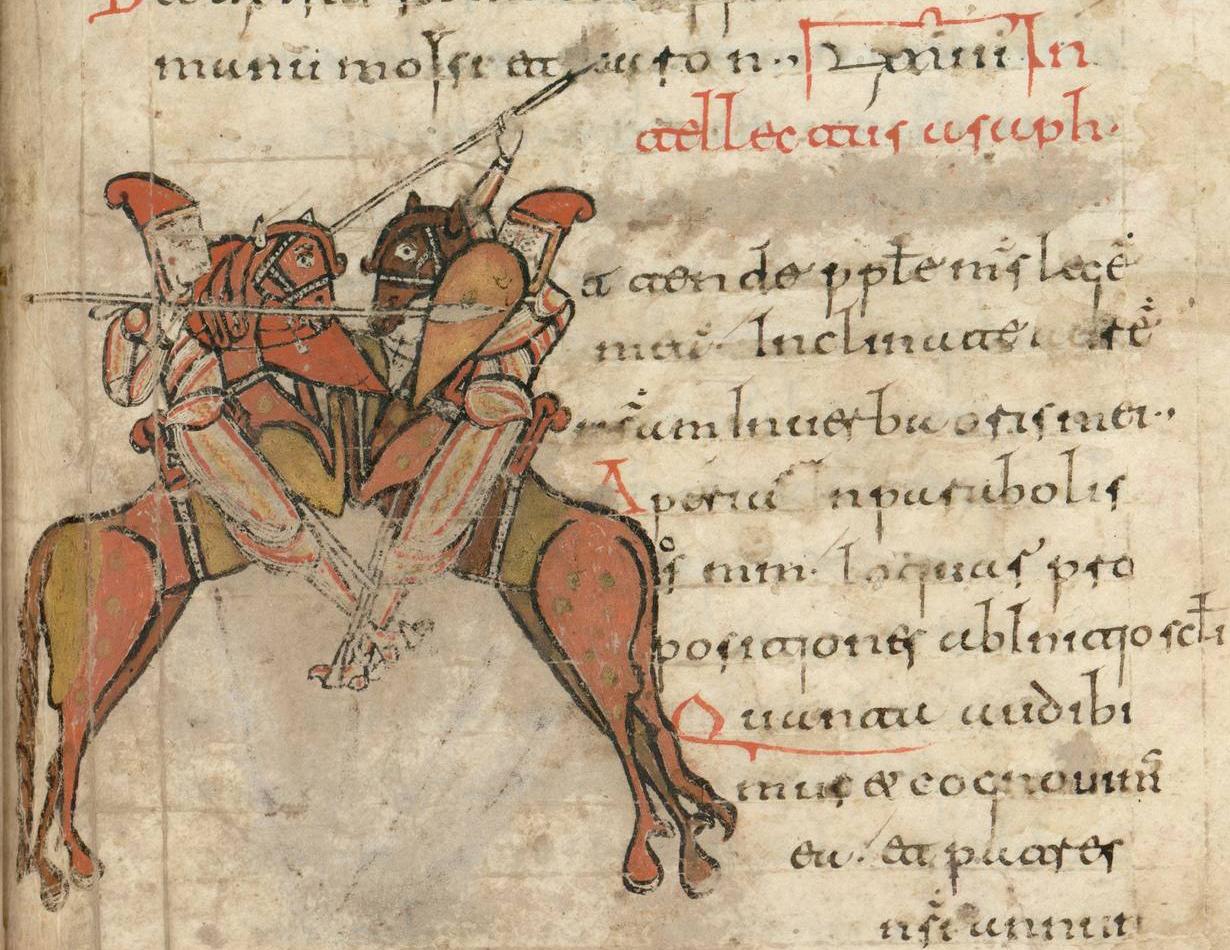Create an Amazon Wedding Registry

Try Amazon Audible Premium Plus and Get Up to Two Free Audiobooks
Illustration from the:
Psalter of San Millan de la Cogolla, 11th century AD
Biblioteca da la Real Academia de la Historia, Madrid
A Cavalry Combat

A Mozarabic manuscript.
[Biblia. V.T. Psalterium] ; [Liber canticorum] [Cod. 64 bis]
Contiene versiones de la Biblia Vetus Latina y Vulgata. Procede del Monasterio de San Millán de la Cogolla.
Contains Bible Versions Vetus Latina and Vulgate. It comes from the Monastery of San Millán de la Cogolla.
Source: Real Academia de la Historia
Referenced on p.22, The Moors - The Islamic West - 7th-15th Centuries AD by David Nicolle
This scene of cavalry combat in the Psalter of San Millan de Cogolla was painted in the 11th century.
The horsemen are clearly Muslims, while the emphasis given to the cloths around their heads may be an early attempt to represent Murabit warriors.
Nevertheless, they carry the kite-shaped shields normally associated with Western European knights,
and their horse-harness appears identical to that used by northern Spanish warriors. (Bibliotece de la Academia de la Historia, Madrid, Spain)
Referenced on p.148, Arms and Armour of the Crusading Era, 1050-1350, Western Europe and the Crusader States by David Nicolle.
364 Psalter of San Milan de la Cogolla, Castile, 11th century
(Archivo del, Real Academia de la Historia, Madrid, Spain)
The horsemen in this miniature seem to be 'Moors', or at least men equipped in a largely Islamic fashion.
Their costumes, with head-cloths around their chins, and their apparent bamboo-hafted spears look distinctly North African.
Yet their pointed shields, high saddles and straight-legged riding position do not fit such an interpretation.
Perhaps these men represent Murābṭîn who have settled in al Andalus and been influenced by Andalusian military styles.
A late 11th or early 12th century date may therefore be more suitable for this manuscript.
Referenced as figure 510 in The military technology of classical Islam by D Nicolle
510. Manuscript, Psalter of San Millan de la Cogolla, 11th century AD, Mozarab, Bib. da la Academia de la Historia, Madrid (Chu).
pp.90-91 By the 12th century the Muslim qunṭārīyah was clearly regarded as a relatively short and heavy cavalry weapon made of beech, fir or other woods, though not of bamboo. It was used by both Saracens and Franks in the Middle East.29 Its blade, ʿarāḍ was broad and acorn-shaped30 and may have been designed for both thrusting and lateral cutting strokes. Such blades were occasionally very large indeed. Here it might be worth noting that four lance blades, recovered from the 11th century Islamic shipwreck in the Aegean, were also quite large, being some thirty centimetres in length, excluding their sockets.31 These and smaller versions appear in many pictorial sources
(Figs. 3, 15, 26, 130, 156, 185, 243, 267, 268, 287, 290, 292, 300, 303, 323, 336, 385, 392, 394, 429, 447, 497, 498, 504, 507, 510, 514, 418, 521, 531, 540, 542, 543, 544, 545H, 547 and 609).
----------------------
29. Al Tarṣūṣī, op. cit., p. 113; Usāmah ibn Munqidh op. cit., pp. 38-39 and 74-75; ʿImād al Dīn, op. cit., pp, 16 and 191.
30. Al Tarṣūṣī, loc. cit.
31. Bass, "A Medieval Islamic Merchant Venture," p. 92.
p.238 What are not mentioned are a whole series of smaller, often hand-rather than arm-held, kite-shaped shields, many of which have rounded rather than pointed bases,
which could provide a logical link between the ancient oval shield and the heavy European kite-shaped cavalry shield of the 11th and 12th centuries
(Figs. 149, 154, 159, 161, 204, 220B, 227, 267, 301, 392, 393, 415, 422, 484, 510, 514, 515, 521, 523, 524, 527, 530, 531, 533, 538, 540, 543, 545, 549, 552, 575, 577, 586, 587, 604, 606, 610, 625 and 638).
p.433 Such mail hauberks, with or without mail ventails across the faces do appear in northern Spanish illustrations of "enemies,"
and in Mozorabic art worn by both infantry and cavalry (Figs. 499, 515 and 517).
The majority of Andalusian, and indeed of Spanish, cavalry would still not have owned hauberks.
They might, however, have worn felt or leather armour of a style similar to that seen in the 10th century (Figs, 497, 499, 511 and 514).
One such armour is almost certainly worn by a foot soldier in a Mozarabic manuscript from this period.
Here it seems to be made of large pieces crudely stitched together (Fig. 517).
Yet these illustrated sources remain far from clear.
Others, which may show Andalusian warriors, almost certainly illustrate unarmoured light cavalry,
although even here a hauberk could be hidden beneath another garment in a style fashionable elsewhere in Islam (Figs. 490 and 510).
Saint George slays the Dragon on Folio 18r, Psalter of San Millan de la Cogolla
Other Spanish and North African Illustrations of Costume & Soldiers


